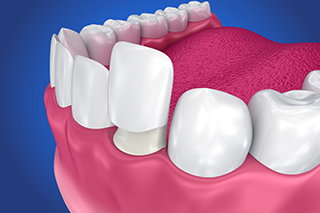Veneers
A dental veneer is a thin, durable porcelain shell that is custom-fabricated to cover the front of a tooth. Veneers can restore the appearance of teeth with chips, cracks, and stains, can close small gaps between the teeth, and can reshape misshapen or slightly misaligned teeth.

Veneers are a popular choice for cosmetic enhancement because they are a straightforward and natural-looking way to create a brighter and more uniform smile. The veneer process is completed over several appointments:
- Consultation: You and your dentist discuss your goals for your smile and whether you’re a good candidate for veneers.
- Examination: Your teeth and gums are examined. Measurements, photographs, X-rays, and impressions are taken as needed.
- Preparation: A small amount of enamel is removed from the front of the tooth so that the veneer will fit flush with the tooth surface. An impression is taken of the prepared tooth and the teeth around it, and a color is chosen for the porcelain.
- Fabrication: The veneers are lab-fabricated to the desired shape and size, using the dental impression and the dentist’s detailed instructions for a precise fit and tint.
- Application: When the veneers are ready, they are placed at a final appointment. After checking for shape, color, and fit, and making adjustments if necessary, your dentist will clean the teeth and use dental cement to bond the veneers in place.
Are Veneers Right for You?
Before deciding on veneers, discuss with your dentist whether they’re the right choice for you:
- Veneers Are Permanent: Prepping for a veneer requires the removal of a small amount of tooth enamel, so veneers will need to be replaced if they are damaged or dislodged. Proper care keeps veneers their best and brightest.
- Veneers Aren’t for Everyone: Teeth and gums must be healthy before beginning the procedure. More serious orthodontic misalignments and habitual conditions such as tooth grinding and jaw clenching make veneers impractical.
- The Advantages of Veneers: While there are less expensive options for cosmetic restorations, veneers offer benefits that whitening and bonding treatments don’t.
- Veneers cover staining which whitening treatments alone can’t eliminate.
- The porcelain used is semi-translucent, like actual enamel, so the veneers will look more natural than bonding. Veneers are more stain resistant, too.
- Veneers are less vulnerable to chipping or other damage than bonding, and have a longer lifespan, typically lasting from ten to 15 years with proper care.
While the cost of veneers is comparable to the cost of crowns, veneers preserve more of the tooth’s underlying structure than crowns do.
If chips, gaps, stains, cracks, misshapen teeth, or other small imperfections in your smile are causing an outsized impact on your confidence, talk to your dentist to discover how veneers could be the right choice to restore and enhance your smile.
